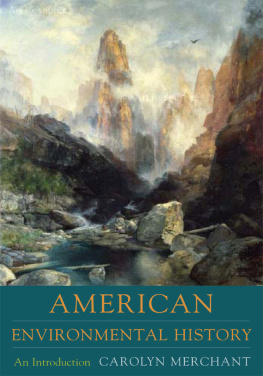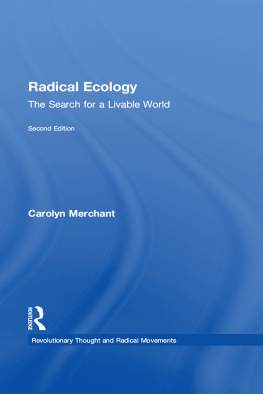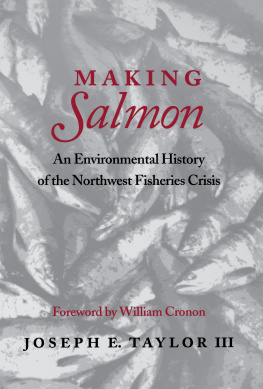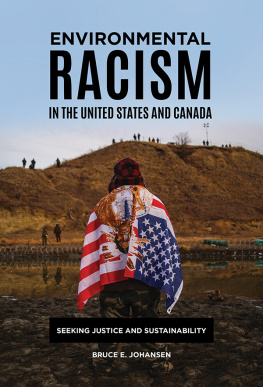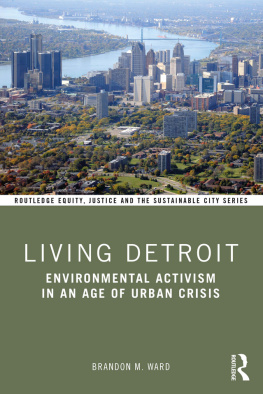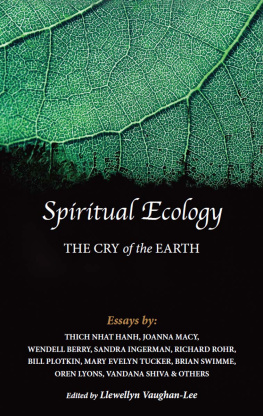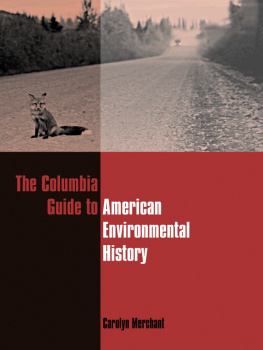American Environmental History
AMERICAN ENVIRONMENTAL HISTORY
An Introduction
Carolyn Merchant
Columbia University Press
New York
Columbia University Press
Publishers Since 1893
New York Chichester, West Sussex
cup.columbia.edu
Copyright 2007 Columbia University Press
All rights reserved
E-ISBN 978-0-231-51238-1
Library of Congress Cataloging-in-Publication Data
Merchant, Carolyn.
American environmental history : an introduction / Carolyn Merchant.
p. cm.
Includes bibliographical references and index.
ISBN: 978-0-231-14034-8 (cloth : alk. paper)
ISBN: 978-0-231-14035-5 (pbk. : alk. paper)
1. Human ecologyUnited StatesHistory. 2. NatureEffect of human beings onUnited StatesHistory. 3. Landscape changesUnited StatesHistory. 4. United StatesEnvironmental conditions. I. Title.
GF503.M47 2007
333.720973dc22
2007015401
A Columbia University Press E-book.
CUP would be pleased to hear about your reading experience with this e-book at .
Contents
European Colonization
Corn Mother
Maine Beaver Pond
Bison Herd on Great Plains
New England Forest
Plimoth PlantationPlymouth, Massachusetts
Working the Land
Pine Ridge Reservation
The Town of Secota, by John White
Slave Quarters, Berkeley Plantation, Virginia
Winnowing Rice
The Cotton Gin, Invented by E. Whitney in 1793
Boll Weevil
Booker T. Washington
Man of the Signs, 1782
Steam Locomotive Arriving at Walden
Phillis Wheatley
Horatio Greenough, The Rescue (1853)
Aleutian Islanders Baidarka
Indian, Chinese, and European Gold Miners
Hydraulic Mining
Columbia River Fish Wheel, ca. 1880
South Pass, Continental Divide, Wyoming
A Cimarron family on relief, 1924
Pittsburgh in the 1890s
Downtown Traffic Jam, Dearborn and Randolph Streets, Chicago, ca. 1910
Dumping Ashes and Rubbish from Barges at Sandy Hook outside New York Harbor, ca. 1900
Gary, Indiana, Air Pollution
Desert Land, Anza Borrego, California
Cattle Grazing in Sagebrush
Early Yosemite Tourists at Mirror Lake
The Scenic Northwest Guide, Great Northern, a Dependable Railway
Stages in civilizing the Indian
Mary, Southern Miwok, ca. 1910
Karl Bodmer, Piochkiaiu (Distant Bear), Piegan Blackfeet Man
Minings Impact on the Land, McLaughlin Mine, California
Ellen Swallow Richards Sanitary Lab at MIT, 1887
Secondary Succession in Disturbed Areas
Eltonian Pyramid of Numbers and Energy (hypothetical)
Population Growth, 1 A.D. to 2000
Boys Looking through Dow Chemical Companys Fence, Morrisonville, Louisiana
El Puente Ojo Cafe, New York City
Corporate globalization
Writing American Environmental History has afforded me the unique opportunity to review and synthesize developments and resources in this relatively new and dynamic field. Environmental history emerged out of 1960s concerns over the impacts of pesticides, population, urbanization, and technologies on the environment. Propelled by popular interest in the state of the environment following Earth Day 1970, many people began rethinking the relationships between the environment and academic fields such as history, ethics, political science, and economics. The American Society for Environmental History was founded in 1977, a year following the publication of the first issue of the journal Environmental Review (subsequently called Environmental History Review), which merged with Forest History in 1996 to become the journal Environmental History. A second journal published in England, entitled Environment and History, was launched in 1995. As the field has continued to grow, articles pertaining to the history of the environment have appeared in many journals and magazines. American Environmental History presents a survey of the field that includes an overview of topics and themes, a compendium of persons, concepts, and laws, a chronology of major historical events, and a guide to additional resources. The second edition adds several new topics to the historical overview and updates and expands the other sections of the book. No book of this type can ever be complete in light of the many topics and resources that continue to emerge in the environmental history field, and difficult decisions have led to what is included in this volume.
Although the final product published here is my own, I would like to thank the many persons who have made substantial contributions to the outcome. I owe much to the inspiration and careful guidance of my editor, James Warren of Columbia University Press, and to Joshua Lupkin, Nickolas Frankovich, and Leslie Bialler for editorial assistance in preparation of the first edition and to Wendy Lochner, Senior Executive Editor, for guidance in preparation of the second edition.
The final draft of the first edition was prepared at the National Humanities Center and I am grateful to the John D. and Catherine T. MacArthur Foundation for supporting my work there as a fellow in the ecological humanities. Jessica Teisch compiled the bibliography, incorporating materials she had prepared for the National Humanities Center with funding from the National Endowment for the Humanities. Under a grant from the Committee on Research of the University of California at Berkeley, Alison Lozner compiled materials for the topical compendium, bibliographical essay, and the visual and electronic resources sections. Valerie Peters and Joshua Volz contributed many of the details in the chronology and William Yaryan, Earth Trattner, and Yvan Chantery assisted with materials included in the historical overview of topics and themes and in the sections devoted to visual and electronic resources. In preparing the second edition, I am particularly indebted to Rob Weinberg, who updated the bibliography, electronic, and visual resources sections and checked many details of the content. I thank Shana Cohen, Earth Duarte-Trattner, and Michael Starkey who also made contributions to the Bibliography. Celeste Newbrough prepared the index for both editions with funding from the University of California at Berkeleys Committee on Research.
I would like to thank Shepard Krech III and Timothy Silver, colleagues for three different summers in the Nature Transformed seminar at the National Humanities Center, for their ideas, careful reading, and many suggestions for the historical narrative. I am grateful to Toivo Finn for permission to use the painting by author, artist, and activist Monica Sj (19382005), Corn Mother at New Grange. Her work may be viewed at: http://www.monicasjoo.org. I would also like to thank my students and teaching assistants in my course American Environmental and Cultural History, taught since 1979, for their ideas and contributions to the intellectual content and methodology of the course and the field. I am indebted to my partner and husband, Charles Sellers, whose inspiration and intellectual contributions over many years have played a major role in my interpretation of American history and to whom I am deeply grateful for reading, editing, crafting, and rethinking portions of the historical narrative. Final responsibility for the content of the book is, of course, my own.
CM
Berkeley, California

